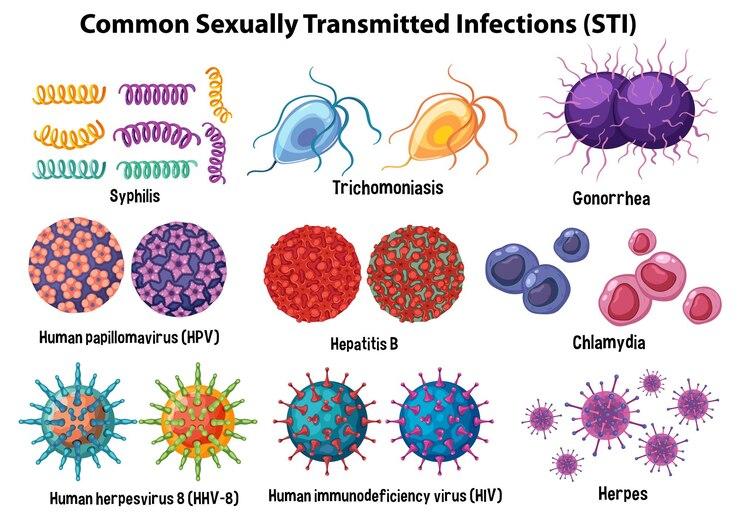Table of Contents
Sexually Transmitted Infections (STIs)
Sexually transmitted infections (STIs), commonly referred to as sexually transmitted diseases (STDs), are a worldwide health issue impacting individuals of all ages and genders. While there is always danger associated with sexual activity, women frequently have particular concerns about STIs. By providing information on STIs, how to prevent them, and safe sexual behaviour, this blog post hopes to empower women.
Understanding STIs
Sexually transmitted infections, or STIs, are infections that spread from one person to another. These illnesses may be brought on by parasites, viruses, or bacteria. STIs that are common include:
- Chlamydia
- Gonorrhoea
- Trichomoniasis
- Bacterial vaginosis (BV)
- Human papillomavirus (HPV)
- Herpes simplex virus (HSV)
- Hepatitis B
- HIV
Why are Women More Susceptible to Certain STIs?
Women are more likely to contract STIs due to a number of biological variables:
Vaginal anatomy
Compared to men, women’s genital tracts are located closer to the rectum, which may raise the possibility of transmission during anal intercourse.
Cervical opening
During menstruation and after puberty, the cervix, the opening to the uterus, is more exposed, which may make it easier for infections to enter.
Vaginal microbiome
An important part of the vagina’s protection against infections is the balance of bacteria there. An imbalance of this kind, such as that caused by BV, can make someone more susceptible.
Symptoms and Complications of STIs in Women
STI symptoms in females can differ according on the type of infection. It’s possible for some women to have no symptoms at all. But typical symptoms can include:
- Burning or pain during urinating
- Vaginal discharge that has an odd hue or smell
- Pelvic discomfort
- unusual bleeding in the vagina
- ulcers or blisters surrounding the genitalia
If STIs are not treated, women may experience major consequences, including as:
- Pelvic inflammatory disease (PID): Inflammation of the reproductive organs that can lead to both chronic pain and infertility is known as pelvic inflammatory disease, or PID.
- Ectopic pregnancy: A fertilized egg implanting outside the uterus is known as an ectopic pregnancy, which is a medical emergency.
- Cervical cancer: HPV infection is a key risk factor for cervical cancer, which increases the chance of developing the disease.
- Complications during pregnancy: A few sexually transmitted infections can raise the chance of miscarriage or an early birth.
STI Prevention: A Handbook for Safe Sexual Activity
Many STIs are preventable, which is excellent news. Listed below are some essential self-defense tactics for women.:
Get vaccinated
There are vaccines against Hepatitis B and HPV that can greatly lower the chance of contracting these illnesses.
Practice consistent condom use
A great way to stop the spread of STIs during vaginal and anal intercourse is to use latex or polyurethane condoms.
Consider dental dams for oral sex
For further protection during oral sex, a tiny latex square called a dental dam can be placed over the genitalia or anus.
Communication is key
Discuss sexual history and STI testing with your partner(s) in an honest and open manner.
Regular check-ups and STI testing
Make an appointment for routine checks with your physician and, if advised, get tested for STIs. The number of tests you receive may vary based on your sexual history and risk factors.
Beyond Prevention: Addressing Myths and Stigma
Regrettably, stigma and misconceptions surrounding STIs are common. The following are some crucial things to keep in mind:
- STIs are not a moral failing: everybody who engages in sexual activity has the potential to have one.
- Numerous STIs are curable: Complications can be avoided with early detection and treatment.
- Getting tested is responsible: Approach to safeguard yourself and your partner(s), thus there’s no guilt in doing so.
Common STIs and Their Prevention
Sexual contact is the primary method of transmission for infections known as sexually transmitted infections (STIs) or sexually transmitted diseases (STDs). These illnesses may be brought on by parasites, viruses, or bacteria. The most prevalent STIs and their preventions are broken down as follows:

Chlamydia
Caused by: Chlamydia bacteria
Symptoms: Typically doesn’t display any symptoms, but in women, it can lead to pelvic pain, irregular vaginal discharge, and pain when urinating.
Prevention:
- It is recommended to wear condoms appropriately and regularly during both vaginal and anal intercourse.
- It is also advisable to get tested frequently, especially if you are dating someone new, as there is no vaccination to prevent chlamydia.
Treatment: Antibiotics.
Gonorrhea
Caused by: Gonorrhea bacteria
Symptoms: May make women experience pelvic pain, uncharacteristic vaginal discharge, and a burning feeling when they urinate.
Prevention:
- Consistent and correct condom use during vaginal and anal sex.
- Avoid having oral sex with someone who exhibits throat or mouth sores. Regular testing is advised because condoms are not 100% effective.
- There is no vaccine against gonorrhea.
Treatment: Antibiotics.
Trichomoniasis
Caused by: Trichomoniasis parasite
Symptoms: Can give women abnormal discharge that smells fishy, as well as burning and irritation in the vagina.
Prevention:
- Consistent and correct condom use during vaginal and anal sex.
- having only one sexual partner and practicing mutual monogamy with someone who has had a trichomoniasis test and treatment.
- Refraining from douching, which may upset the normal balance of microorganisms in the vagina.
Treatment: Medication.
Bacterial Vaginosis (BV)
Caused by: Not a sexually transmitted infection (STI), but an imbalance of the normal bacterial population in the vagina.
Symptoms: May produce burning and itching in the vagina, as well as a thin, gray discharge that smells like fish.
Prevention: BV isn’t an STI but here are some ways to reduce your risk:
- To ensure proper hygiene, wash your vulva with warm water and a small amount of soap.
- Dress in air-breathable cotton underwear.
- Avoid using antibiotics unless a doctor has prescribed them, as they can disturb vaginal microorganisms.
Treatment: Antibiotics.
Human Papillomavirus (HPV)
Caused by: A very prevalent virus that is spread via sexual contact and other skin-to-skin contact.
Symptoms: Numerous HPV strains exist, some of which might result in cervical cancer or genital warts.
Preventions:
- HPV can be prevented with vaccination, and certain types can be treated.
- The HPV vaccine is quite efficient at preventing genital warts and cervical cancer caused by the most prevalent strains of the virus.
- Although using condoms correctly and consistently can lower the risk of transmission, it is not 100% effective because skin-to-skin contact can still transmit HPV.
- HPV-related precancerous cervical alterations can be found with routine Pap screenings.
Herpes simplex virus (HSV)
Caused by: HSV virus
Symptorms: produces herpes, which can lead to painful blisters or sores around the mouth, rectum, or genitalia.
Preventions:
- No vaccine is currently available to prevent all strains of HSV.
- Although using condoms correctly and consistently can lower the chance of transmission, it is not 100% effective because the virus can still spread by skin-to-skin contact.
- One way to stop transmission is to avoid having oral intercourse with someone who is clearly experiencing an epidemic.
- Medication suppression may lessen the occurrence and intensity of breakouts.
- Herpes has no known cure; however treatment can help control outbreaks.
Hepatitis B
Caused by: a viral infection of the liver.
Symptoms: Can result in yellowing of the skin and eyes (jaundice), exhaustion, nausea, and vomiting.
Prevention:
- Hepatitis B vaccination is highly effective in preventing infection.
- Preventing unprotected contact with an individual who has Hepatitis B. Consistent and appropriate condom use can lower the risk of transmission.
Treactment: Vaccine can prevent it, and medication can treat it.
HIV
Caused by: HIV Virus
Symptoms: The virus responsible for the acquired immunodeficiency syndrome, or AIDS.
HIV impairs immunological function, making the body less able to fight off infections.
Preventions:
- Consistent and correct condom use during vaginal and anal sex.
- For those who are at high risk, a medicine called pre-exposure prophylaxis, or PrEP, can dramatically lower their chance of HIV infection.
- To lower the risk of infection, post-exposure prophylaxis (PEP) is a medicine that can be administered no later than 72 hours following a possible HIV exposure.
- Using sterile needles and syringes is one way to reduce the risk of HIV transmission among drug injectors.
Treatment: HIV cannot be cured, but treatment can let infected individuals live long, healthy lives.
Remember that this is not a comprehensive list of all STIs. It’s crucial to visit a physician or other healthcare professional to be tested for and treated if you think you might have a STI. Serious health problems can be avoided with early STI diagnosis and treatment.
Remember
- It’s critical to be open and honest with your partner(s) about your sexual history and STI testing.
- As advised by your physician, routine examinations and STI testing are crucial for early identification and treatment.
- Testing for STIs is not anything to be ashamed of. It’s a responsible measure to keep your partner(s) and yourself safe.



